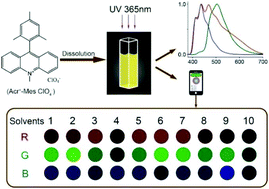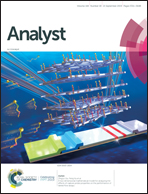A single 9-mesityl-10-methylacridinium ion as a solvatochromic sensor array for multicolor visual discrimination of solvents†
Abstract
We report a single 9-mesityl-10-methylacridinium ion (Acr+-Mes) as a solvatochromic sensor array for multicolor visual discrimination of solvents. The composite fluorescent response of Acr+-Mes to polarity, dispersed state, and lone-pair–π interactions produces different colors when it is dissolved in various solvents. The corresponding RGB values as sensing elements are extracted to create distinct fluorescence response patterns for each solvent. With the help of principal component analysis, common solvents, such as water (H2O), absolute ethanol (EtOH), acetonitrile (MeCN), dimethyl sulfoxide (DMSO), acetone (CO(Me)2), dichloromethane (DCM), trichloromethane (TCM), tetrahydrofuran (THF), toluene (PhMe), and tetrachloromethane (CCl4), are successfully discriminated and identified with an accuracy of 100%. What's more, this sensor array can also discriminate binary solvent mixtures and quantitatively detect DMSO in organic and inorganic solvents.



 Please wait while we load your content...
Please wait while we load your content...